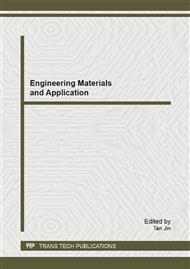[1]
Renewable Energy Policy Network for the 21st century (REN21), Renewables 2010 Global Status Report, Paris, 2010, 1–80.
Google Scholar
[2]
Birkmire RW, Eser E. Polycrystalline thin-film solar cells: present status and future potential. Annual Review of Materials Science 1997(27), 625-653.
DOI: 10.1146/annurev.matsci.27.1.625
Google Scholar
[3]
Kao YH, Kazmerski L, Lynn KG, Mascarenhas A. Photovoltaic characterization: an overview. Electrochemical Society Proceedings 1999, 289-300.
Google Scholar
[4]
Zweibel K. Thin-film PV manufacturing: materials costs and their optimisation. Solar Energy Materials and Solar Cells 2000; 63(4), 375-386.
DOI: 10.1016/s0927-0248(00)00057-x
Google Scholar
[5]
Zhao Ying, Dai Song-yuan, Sun Yun , Feng Liang-huan; Status and Trends of Thin Film Solar Cells; Chinese Journal of Nature, V01. 32 No. 3, 156-160.
Google Scholar
[6]
BoZhan Qian, Technology and application of Solar energy, Beijin: Science Press, (2010).
Google Scholar
[7]
K.L. Chopra, P.D. Paulson, V. Dutta. Thin Film Solar Cells: An Overiew rog. Photovolt: Res. Appl. 2004(12), 69-92.
DOI: 10.1002/pip.541
Google Scholar
[8]
Harald Hoppea and Niyazi Serdar Sariciftci, Organic solar cells: An overview, Mater. Res., Vol. 19, No. 7, Jul 2004, 1924-(1945).
Google Scholar
[9]
Mario Pagliaro, Giovanni Palmisano, Rosaria Ciriminna, Flexible Solar Cells, Shanghai: Shanghai Jiao Tong University press, (2010).
Google Scholar
[10]
Martin A. Green, Keith Emery, Yoshihiro Hishikawa, Wilhelm Warta, Ewan D. Dunlop, Solar cell efficiency tables (version39), Progress in Photovoltaics: Research and Applications . January 2012, Volume20, Issue 1, 12-20.
DOI: 10.1002/pip.2163
Google Scholar
[11]
REPINS I, CONTRERAS M A. EGAAS B, et al. 19. 9%-efficient Zno/CdS/CuInGaSe2 solar cell with 81. 2% fill factor. Progress in Photovoltaics: Research and Applications, 2008, 16(3), 235-239.
DOI: 10.1002/pip.822
Google Scholar
[12]
Kim J Y, Lee K, Coates N E, et al. Efficient tandem polymer solar cells fabricated by all-solution processing. Science, 2007(317)222-225.
DOI: 10.1126/science.1141711
Google Scholar
[13]
Edit by reseach organization of solar energy photovoltaics technology, The foundation and application of thin film solar cells , Beijing : China Machine Press, (2011).
Google Scholar
[14]
Marti A and Araujo GL, Limiting efficiencies for photovoltaics solar conversion in multigap systems, Solar Energy Materials and Solar Cells 1996(43)203-222.
DOI: 10.1016/0927-0248(96)00015-3
Google Scholar
[15]
Noufi,R. and Zweibei,K. High-efficiency CdTe and CIGS Thin film Solar Cells: Highlights and Challenges. WPEC4, Hawaii, (2006).
DOI: 10.1109/wcpec.2006.279455
Google Scholar
[16]
Yella. A, Lee. HW, Tsao. HN, Yi. C, Chandiran. AK, Nazeeruddin. MK, Diau. EW-D, Yeh. C-Y, Zakeeruddin. SM, Grätzel. M, Porphyrin-Sensitized Solar Cells with Cobalt (II/III)–Based Redox Electrolyte Exceed 12 Percent Efficiency. Science 2011 (6056) 629-634.
DOI: 10.1126/science.1209688
Google Scholar



